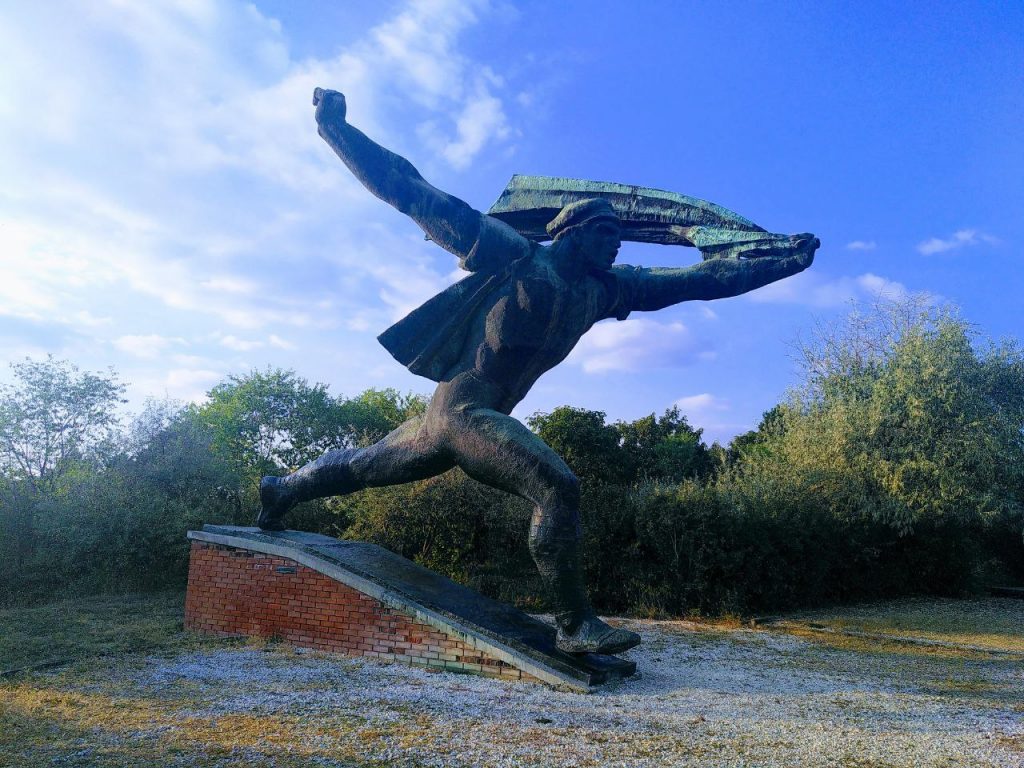Propaganda in capitalist Hungary
It’s a strange feeling walking through Memento Park, a site about 40 minutes outside of Budapest where statues and memorials from Hungary’s socialist period stand like six rings of gravestones around a 5-point star. A gift shop at the entrance sells badges and fridge magnets with pictures of Marx and Lenin, and a CD of old communist songs plays over the sound system.
When Hungary’s communist government fell along with the rest of the socialist bloc in 1989, markers of the old state were swept from the city: old powers were done away with, street names were changed, and statues were either destroyed or moved to museums and tourist spots like this one. These sites now attempt to contain the memories attached to these objects, commodifying their revolutionary aesthetics while erasing their revolutionary significance. In this park, an exhibition on the evils of socialism helps situate these statues of Hungarian revolutionaries, working men and women, Soviet soldiers, and communist thinkers within a safe framework of cultural propaganda — this is a theme park, or a museum of horrors. It is not a good idea.
Capitalist Hungary is only 32 years old, but in that time, reactionary forces have already managed to spread their liberal and fascistic propaganda throughout every aspect of Hungarian life — from the education system, to the media, to cultural institutions and tourism. With consistent repetition, they have had great success burying any merits or lessons to be drawn from Hungarian-style socialism under the old tropes of authoritarianism, bloodthirsty Russians, and the newfound freedoms of liberal capitalism.
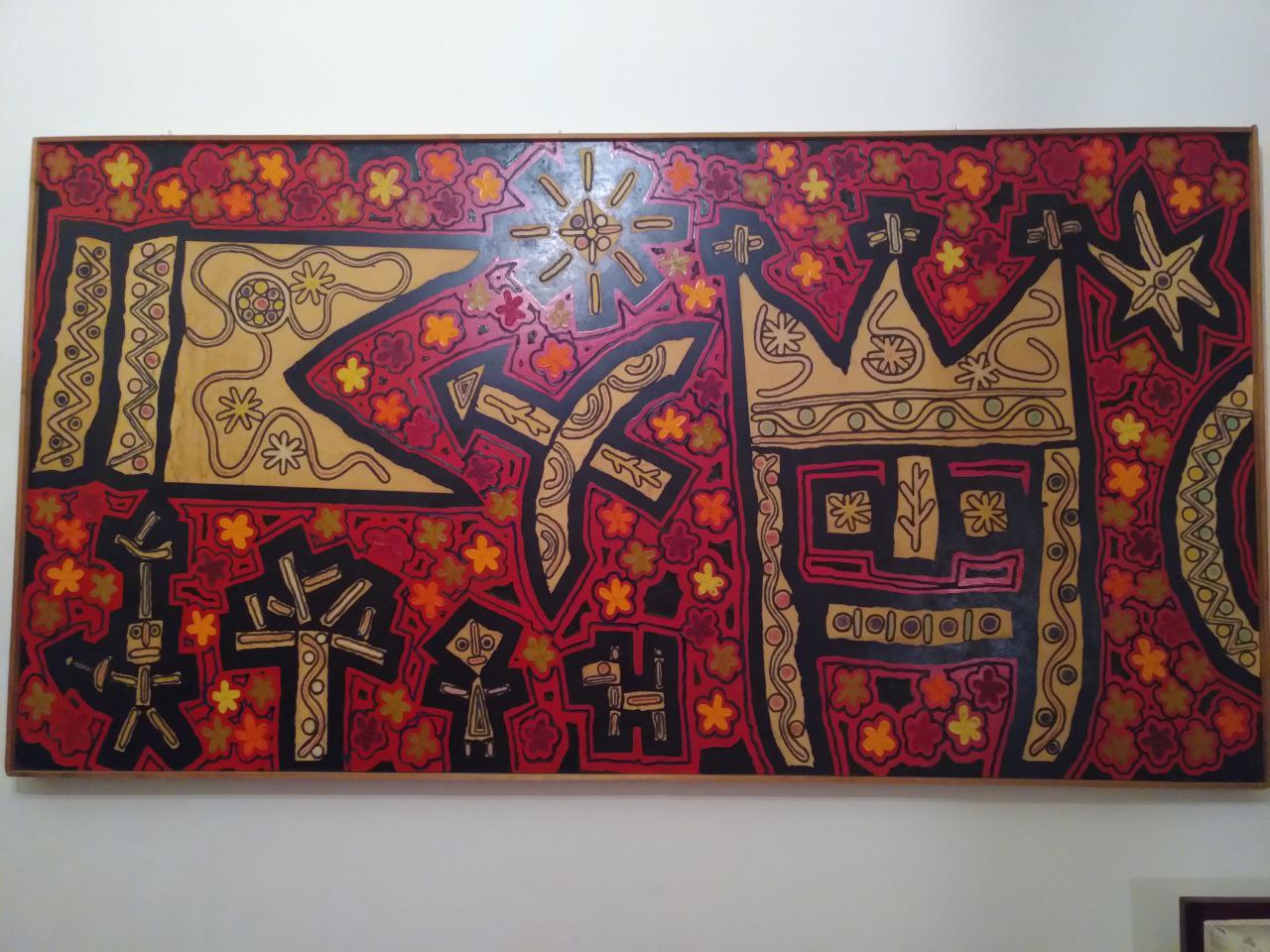
Some of these tropes can be seen in the art of my grandfather, a surrealist painter who never found much success during his life under socialism. Although most of his work focused on abstract patterns and naked women, a few also contained anti-Soviet imagery, and it’s this last type which earned him recognition after his death in a 2018 exhibition to the ‘forgotten artists’ of Hungary’s socialist period. The anti-Soviet elements may indeed have led to his censorship during the heightened tensions of the Cold War, but my grandfather’s lack of success during his life could also be attributed to the many other reasons artists don’t get discovered, or to his well-known protectiveness over his work. Yet ultimately, it was the story of a censored artist under an ‘authoritarian regime’ that put him in the Budapest Hall of Art in Heroes’ Square, presenting him with a platform only made available under the leadership of this new system.
Viktor Orbán’s government is the latest, miserable formation of this new state, but the worst part to the liberals who loathe him is that he’s got where he is today by playing by their rules. He has gamed the new system and built up this distinction between ‘good liberal democracy’ and ‘bad authoritarian socialism’ in order to sow propaganda and secure power for himself. One example of this is how he often revives the memory of 2006, the year when a demonstration led by right-wing Fidesz supporters against the centre-left government of Ferenc Gyurcsány ended in violence. Police officers were attacked and retaliated with tear gas and water cannons to disperse the crowd. Now, Orbán just needs to point at this moment and say:
“Look, how these authoritarian socialists continue to try to crush our freedoms! Where is our right to protest?”
And many people will vote for him, as though political oppression does not manifest itself most fiercely and violently under capitalist states. It is presented as though Orbán’s demonstrators were non-violent, and Gyurcsány was any less ‘authoritarian’ than he is. Orbán is then allowed to claim his title as the stalwart figurehead of Hungarian liberal democracy, while at the same time making a mockery of it. Gyurcsány continues to be blamed for ‘authoritarianism’ today, and alongside anti-LGBT and anti-migrant rhetoric, he remains a key tool of Fidesz propaganda.

Unfortunately, those searching for hope among the machinations of the liberal opposition may find themselves disappointed, as this EU-backed ragtag coalition of six different parties, ranging from the social-democrats of the MSZP to the reformed fascists of Jobbik, is fragmented at best. Jobbik’s Péter Marki-Zay, a centre-right conservative has recently won the primaries to lead the coalition and run against Orbán next year. His party has worked on its messaging to try to portray a shift towards the centre in recent years (and many liberals will say this when they vote for them), but it was only in 2014 that the Independent was calling them a neo-Nazi party for their platform of detention centres for Roma people, and their position that Hungarian Jews were a ‘national security risk’. Even if the coalition does not collapse under the weight of its own contradictions and actually manages to defeat Orbán next year, the lukewarm manifesto of concessions that they have agreed upon (assuming they would even implement them) would not even begin to return working conditions to the level they were at 30 years ago.
In other words, the failures of liberal capitalism in Hungary are naked for all to see, and despite a socialist alternative in living memory, Fidesz has secured a supermajority 133 of 199 seats in the Hungarian parliament, while the revolutionary left holds zero. So, why has Hungary not seen a resurgence in popularity for socialism? In 2016, Gyula Thürmer, the communist leader of what has now become the Munkáspart or ‘Workers’ Party’ since Orbán banned the use of the word ‘communist’ in party names, gave his perspective on Hungarian attitudes to socialism in an interview:
“The common Hungarian people don’t talk about capitalism or socialism, perhaps they don’t even use these words. They just compare which society, which construction of society can give them more. Socialism or capitalism? It’s not important [to them] what the name of this system is.”
“Naturally, all of the people are under the influence of the official propaganda: newspapers, the media, what they see on television, their education at the schools… But if you go on the streets now and ask Hungarian people ‘When did you live better?’ there are a lot of people who would answer, ‘No, our fathers and grandfathers lived better in the 1970s and ‘80s than we do now in Hungary.’”
Is Thürmer correct in thinking that Hungarian hostility towards socialism comes from anti-communist propaganda, rather than their own experiences of it? Some polling suggests that he is, with a 2010 poll by the Pew Research Center finding that 72% of Hungarians believed that they were worse off now economically than under socialism. In contrast, an Ipsos poll in 2018 found that only 28% of Hungarians believed that socialist ideals were of “great value for societal progress,” indicating a conflict between Hungarians’ felt reality of the benefits of socialism, and their opposition to the ideology itself.
I was curious whether this perspective ran through my own family as well. My mum, my aunt, and my grandmother had all lived under the Hungarian socialism of János Kádár until 1974 when my grandmother married an English man and came to Britain. They have also been back to Hungary nearly every year since, giving them the opportunity to compare the two systems before and after the capitalist restoration of 1989. Has Hungary got better or worse in that time? And without the distortions of propaganda, what was socialist Hungary really like? After speaking to my family and collecting a few photographs, I’ve put together what they said here, focusing on life’s essentials: food, housing, healthcare, etc., as well as a few common criticisms of the period, such as the relationship with Soviet Russia.
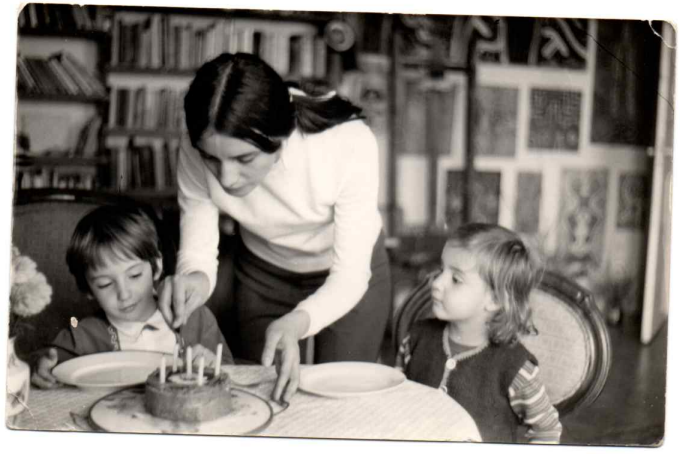
Remembering Hungarian socialism
Hungary has the best food in the world, and in the Hungarian People’s Republic, it was cheap and widely available.
“When we were given money for food as kids, we struggled to spend it all,” my mum remembers, “because an ice cream only cost two forint.”
“And some only cost one,” my grandma said with a smile.
A wide variety of state welfare policies also ensured that, from cradle to grave, no one in the country would go hungry. This included free school meals for children, “Meals on Wheels” deliveries to the elderly, vouchers for workers to eat at workplace canteens, and more. This also had the additional benefit (at least theoretically) of freeing working women from the need to perform the additional unpaid labour of cooking in the home.
Of course, Hungarians under socialism had to live without the seventy-five brands of crisps we have in Britain today, with maybe only one or two different brands per item, but no food was wasted. And with a crisis in child hunger in one of the richest countries in the world being met by the charity of footballers instead of our elected leaders, some would see this as a small change in order to live in a society where everyone has enough to eat.
Like in the rest of the socialist bloc, there was also no homelessness or rough sleeping in socialist Hungary.
“Unless you drank too much and fell asleep outside,” my mum said.
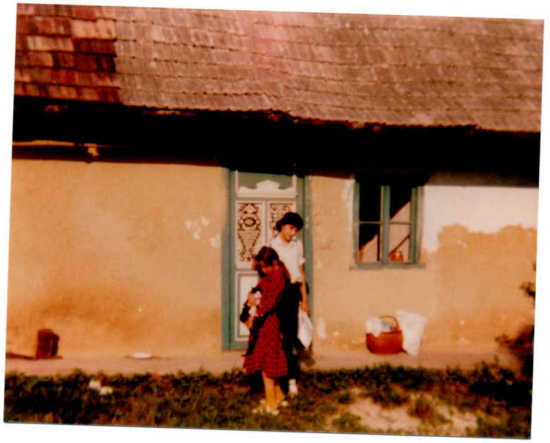
In fact, it was common for many Hungarians, even “starving artists” like my grandfather, to own a small house in the countryside while renting a council flat in the city. The country house had a patch of land for raising a few chickens and growing a bit of food, while the council flat could be used when going to work. Hungary and other current and former socialist countries still have the highest levels of home ownership in the world, but since 1989, rents and house prices have been rising fast, and people in Hungary can now be seen sleeping on park benches for the first time. This has always been a common sight here in Britain, but has skyrocketed since the pandemic.
Healthcare under socialist Hungary was of course completely free, including the dentist. Equally important, however, was its quality. The state of today’s public services weighs heavily on the minds of Hungarians, with common attacks on Orbán calling on him to spend less money on stadiums and more on hospitals. I remember how run down the hospital in Budapest was that I took my grandmother to a few years ago, and it’s easy to draw comparisons with the state of funding and resources for our NHS and GP surgeries in Britain today. Under socialist Hungary, my aunt remembers that:
“GPs weren’t expected to deal with everything, and I could go to them with a problem in the morning and be seen by a specialist in the afternoon.”
As a teacher, my aunt also had a lot to say about the education system, which was completely free from nursery all the way to university:
“It seemed to be more focused on education theory, aimed at providing the best results to the students,” she said.
Aside from 45-minute lessons, smaller classroom sizes, and more prep time for teachers, she also told me that Hungarian children started schooling a year later than we do, a policy which came from research into childhood brain development. She also described a feeling that school was “less hierarchical,” with greater camaraderie between teachers and students, especially as students got older. Of course, schools were all publicly owned, so when my aunt went back to Hungary to teach in the early ‘90s, it was at one of the first private language schools in the country. Government subsidies also meant that school trips were more widely available to ordinary children than in Britain today, with many schools taking their students to see the Soviet Union, for example.
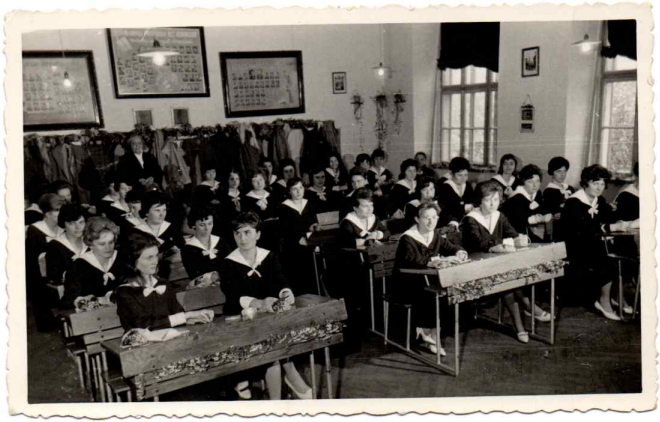

Another fixture of the Eastern European socialist states, like Hungary, was that there was officially no unemployment. In part, this may have been because people like my grandfather were classed as “employees of the state,” whether or not he was actually painting. But it’s fair to say that unemployment was definitely very low, and overemployment was common. One example my aunt gave was going to the stationers to buy herself a sketchpad:
“There’d be one person at the checkout, one to help you find what you needed, and another person to bag it,” she said. “And they all wore orthopaedic shoes. Being on your feet all day isn’t good… Care for your workforce!”
Under socialism, the state-owned businesses and co-operatives that made up the vast majority of the economy were therefore happy to pay more in the way of wages to ensure that everyone had jobs. These wages were modest, but due to state subsidies across all areas of Hungarian life, even small incomes allowed for a good quality of living. My grandmother, for example, was a single mother raising two daughters. She had no university degree, but she managed to get a job working at the archives in Pécs, and even they lived comfortably. Greater wealth equality and welfare also manifested themselves in other ways, including stronger community bonds and almost non-existent street crime. As young women, both my mum and my aunt remember a feeling of safety walking down the streets of Budapest at night.
Different attitudes to labour also went beyond the money you earned as an employee, with a sense that workers were more valued than they are today, and less fear or boss-worship. Workers also received many honours for their services to the country, including “outstanding worker” medals and certificates, like the ones below. My great-grandfather is another example of this respect for workers, though an extreme one. He found fame as a successful archaeologist in Pécs, and as a reward for his discoveries and his contributions to the country, the communist government named a lake after him, a street after him, and gave him a state funeral when he died.

In Hungary today, the life of a worker is very different. By the early ‘90s, an era of mass privatisation had begun, with many Hungarian industries sold off to the highest bidder (usually a foreign capitalist) and then run into the ground. Today, the basic needs of the people aren’t being met, and wealth inequality and poverty have begun to manifest in all kinds of ways, from the elderly women selling flowers and heirlooms on the underground, to people scavenging in bins, to the rise in street crime and the looming threat of fascism.
Your leisure time was also very different under socialism. Cultural activities were massively subsidised by the state and often free for children, meaning that things like the theatre and the opera became available to everyone, regardless of class. The same went for gyms, swimming pools, and even the public baths, which workers would often visit between shifts.
Fashion and dance culture were also very different. At the time, my grandma regretted that young people “didn’t know how good they had it,” but as a teenager, the glitz and glamour of the West had a strong pull over my mum’s generation.

“Like, when you went to a club in Hungary, people would just dress normally and dance however they felt like it,” my mum told me. “Nowadays, I’d probably think it was quite sweet, but at the time, I thought it was really uncool.”
Travel and holidays were also subsidised by the government under socialism, and public transport was so cheap that it was nearly free (although this didn’t stop my great-grandmother from dodging the ticket inspectors). Many companies also owned holiday accommodation in places like Lake Balaton, meaning their employees could take their families here at a huge discount, and travel was affordable to everyone. Holidays were most common within the socialist bloc, as travelling between the West (although easy enough for my family to do so regularly) needed a letter of invitation or a note from your boss, another product of Cold War tensions. My mum remembers the Balaton being a common destination for East Germans, Polish people, Romanians, etc., while people from the West were rarer. International Workers’ Day was also a huge public holiday, with thousands of red flags, balloons, and a parade.
There were also huge steps forward for women’s rights during this time, including more women in the workplace and traditionally male-dominated fields, free nurseries and childcare, and legalised abortion since 1953, 14 years before Britain. There was also four times more paid maternity leave than we have in Britain today, with four years per child instead of one. This was also available for university students, who were treated as employees of the state.
Hungary was still a very Catholic country when socialism was established, but steps were taken towards a separation of church and state, such as abolishing obligatory religious instruction in schools. Homophobia was present, though it manifested in different ways than it does today. Personal attitudes take a long time to change, but my aunt maintains that Budapest used to feel like a much more gay-friendly city than it is now, with many couples open about their relationships and the majority keeping their homophobic views to themselves.
Hungary was also a very white country, to the extent that my aunt didn’t see a black person for the first time until she came to Britain in 1974. This was mainly due to limited migration, but meant that xenophobia and racial ignorance were other problems which wouldn’t be solved overnight. That said, state media and educational and cultural institutions seemed focused on encouraging a form of ‘socialist internationalism’, reflecting a different form of propaganda that encouraged unity, rather than division. Today, the attacks by Fidesz and the capitalist media on queer people, Roma people, and migrants show that propaganda is used in a very different way: to stir up hatred, divide the working class, and build a political base of support around reactionary nationalism and the preservation of traditional family values, rather than actual improvements to living standards.

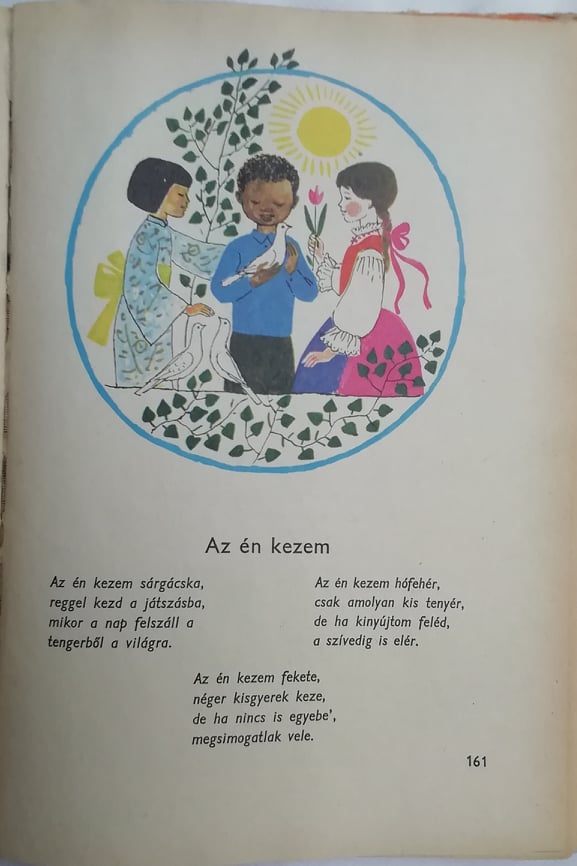
A lot of propaganda in the form of education, culture, and art also focused on strengthening Soviet-Hungarian friendship, an attempt to resolve one of the deepest contradictions, as well as the most important relationships that the country had at the time. Before the first attempts by Mátyás Rákosi to build a socialist economy from the ashes of the World War, Hungary was ruled by Ferenc Szálasi of the fascist Arrow Cross Party, installed after Nazi occupation. Both he and Miklós Horthy, the Hungarian regent who came before him, had collaborated with Hitler to send around 440,000 Hungarian Jews and thousands of Hungarian Roma to their deaths before the war was over. This regime only came to an end when the Soviet Red Army liberated Auschwitz, Hungary, and the rest of Eastern Europe from the Nazis in 1945.
The need for solidarity with the Soviets must also be seen in the context of the Cold War, in which the survival of the socialist system and its achievements mentioned above depended largely on the unity of the socialist bloc, and collapsed when the USSR did. Khrushchev’s decision for military intervention in the 1956 uprising must therefore be understood not through the lens of ‘bloodthirsty Russians’ as pushed by the right, but in the context of how this decision was made. Khrushchev was, for example, initially willing to negotiate a withdrawal of Soviet troops and a relaxation of Soviet influence by accommodating the proposed reforms of new leader Imre Nagy. This decision was only overturned after the killing of hundreds of communist party members and police by some of the protesters, as well as Nagy’s declaration of withdrawal from the Warsaw Pact. This counterbalance to NATO was a crucial line of defence for the Soviet Union and the socialist bloc, and Nagy’s withdrawal from it was seen as a betrayal which would have certainly threatened their collapse.
That said, the deep instability and violence that defined this year cannot be understated. Many Hungarians left the country, such as my great-great uncle’s family who began new lives as U.S conservatives. Others, like my grandmother’s family, decided to stay behind. She was 12 years old at the time and remembers seeing a man get shot in Budapest before she could leave the city for Pécs, though she doesn’t remember who’s side he was on. Her father was also imprisoned for six months around this time, although the exact reason (anything from “mouthing off to an official” to active support in ‘56) is unclear. Among these events were some very legitimate desires for national sovereignty in the midst of the Cold War, but attempts by the right to revise history and distil what transpired into a ‘popular uprising against communism’ must be rejected.
Suffice it to say that my grandmother’s feelings about the Soviets are complex. She grumbles about having to learn Russian in school, but she enjoyed singing Russian songs. She speaks proudly about piling up and burning the Russian books in her school after the uprising, but also expressed sympathy for those Soviet soldiers stationed away from home for so long. She and her friend once hitched a ride in a Soviet car, and she told me that:
“They really weren’t that bad.”
That said, Anti-Russian sentiment has continued all the way up to the present day. In the ‘80s, my aunt decided to study Russian at university, something which she kept secret from her grandmother for half a year. For a brief time as a teenager, an admiration of Lenin’s victories over the imperialism of the Russian tsar also led her to wear a brass pin of him on her coat. She thought it looked cool, but she attracted some dirty looks on the Budapest underground. Russophobia remains a key weapon of today’s propaganda as well, with Hungarian problems often being blamed on Russia, if not China.
Conclusion

Socialist Hungary was not a utopia and we communists are not utopians. Wealth equality was very high, but corruption meant that some party members got special privileges, which led to resentment and anti-communism. All fundamental needs were met, but bureaucracy and early attempts at socialised and planned production meant long waiting lists for cars and telephones during certain periods, and little choice over what kind you got. The desire for worker sovereignty was also inseparable from a call for a national sovereignty, which many felt was neglected. There were no McDonalds in socialist Hungary, but Coca Cola arrived early.
It’s against the backdrop of all of these contradictions that I walked through Memento Park, thinking of the corruption, the hatred, the division, and the poverty that grips Hungary today. I thought about the black snake of propaganda that wraps its coils around the imaginations of the Hungarian people, attempting to prevent any possibility of envisioning a future beyond capitalism.
We must constantly remind each other of the socialism of the past in order to build the socialism of the future, and with new contradictions to resolve and new global threats to face, communists must be adaptive in working towards not only a socialist restoration in Europe, but a reinvention as well. In Hungary, this will only happen through confronting the imperfections of the past, while also refusing to forget that, just a few decades ago, something existed in one of the poorest countries in Europe that has not been replicated in any capitalist country since, not in the wealthy US, nor ‘progressive’ Scandinavia, and certainly not here in Britain.
For a time, there was no hunger, homelessness, or joblessness in Hungary. And for a time, every Hungarian had access to healthcare, fair pay, and a decent education. For a time in Hungary, workers had become masters of a new, more equal, and more democratic society built on the bones of the fascist and genocidal regimes that had come before. This happened in Hungary, just like everywhere else, not through any single vote in the ballot box, but through the united struggle between workers and communist revolutionaries, following in the footsteps of those who had come before.
As I walked through the park past all the statues and relics and wondered whether socialism could really return to Hungary in our lifetimes, I stopped at a statue of Lenin—one hand stretched up towards the open sky…

…and a wreath left by workers at his feet.

Világ proletárjai, egyesüljetek! Workers of the world, unite!
Eben Dombay Williams, is a member of the YCL’s Glasgow branch

